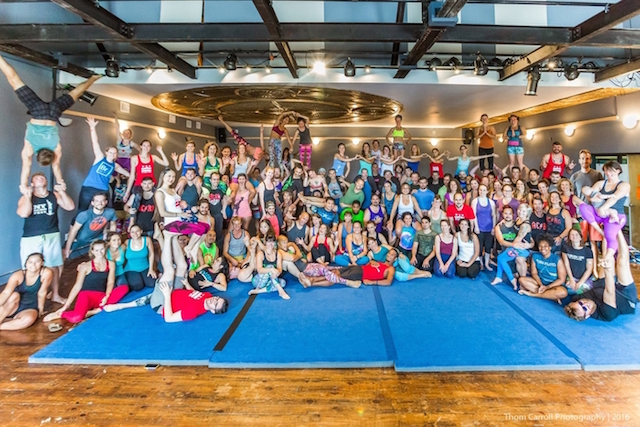“I can’t believe we just did that!”
My first words as a flyer echoed across the room as I exchanged high fives and hugs with my base and spotter. The excitement was contagious, reflecting back at me from a dozen knowing smiles.
They all seem to say, “keep surprising yourself”. What we can do with each other is so much more that what we can do alone.
A couple of years into my acroyoga journey, I’m still surprising myself. I’m forced to be present, and I actively practice exchanging consent and wholeheartedly putting my trust in others. I’m in awe of what my body can accomplish, so instead of wishing to erase cellulite or scars, I embrace them as part of this phenomenal being. I am grateful for the abundance, grace, healing, and love this practice has given me.
Acroyoga, partner yoga, or partner acro is a versatile discipline where a base supports a flyer either while standing or lying down (called L-basing). Whatever the name, acro has something for everyone. Glance around any workshop or jam, and the goals and motivation seem infinite.
From therapeutic partner stretches to gravity-defying gymnastic feats, acro is what you make it. Some shape it into a graceful performing art; others travel and teach. Whatever the pursuit, acroyogis are guaranteed to get fitter and more flexible and will likely to improve their communication skills, build trust, deepen emotional bonds, and foster lifelong friendships.
Strength
Since acroyogis can not only hold a pose but also move through a “washing machine” (a cyclical sequence of poses), they practice both static and dynamic strength exercises and aerobic and anaerobic movement. Furthermore, when safety is a central element, we try even harder to successfully move through a position and may hold it for longer than we ever thought possible.
Flexibility
Partner exercise allows us to move deeper into poses than we would on our own. For flyers, both gravity and the base help facilitate asana if needed. When L-basing, the weight of a flyer gently stretches hamstrings.
Communication Skills
Fun, safe, and effective coordination requires us to be openly honest with ourselves and our partners. Asking consent and learning how to perform accurate self assessments are essential to understanding our own and each partner’s limits and desires.
Beyond verbal communication, acro also enhances nonverbal communication through body language and physical cues. For example, a base may signal where a flyer should shift her weight by pressing his toes into their contact point on her body. Established partners learn each other’s personal communication styles, and practicing with new partners improves our ability to read these cues in others.
Trust
Because of inherent risk, trust is paramount in acro, and it goes hand in hand with communication, especially when practicing with someone new. Respectful practitioners clearly ask for consent, state their goals, frequently ask their partners how they’re feeling and what they need, and are open to feedback throughout each session. Learning to trust others, including strangers, is a powerful healing tool, and there are countless stories of those whose overall outlook and trust in others was transformed by acro.
Emotional Bonds
Trust, verbal and nonverbal communication, and a shared passion make for quickly strengthening bonds in both new and established relationships. Soul-stirring conversations are great, but feeling another human’s weight in our hands or being held up by someone breaches another level of knowing a person.
New Friendships
With all of the above as natural side effects to practicing acroyoga, everyone is bound to make at least one new best friend. When we continue to attend jams, workshops, and festivals, we start to see familiar faces and experience the joy of witnessing each other’s development. After all, nothing is sweeter than creating the best versions of ourselves alongside those we love, supporting each other (emotionally and physically) on our own paths.
Underlying yet transcending all of these is the powerful feeling of being a part of something much larger than yourself. I’ve experienced this in the smallest sense, as the shapes I create alone on my mat could never hope to replicate the endless possibilities available in collaborative movement. I also feel it on an exponentially larger scale, as I extrapolate the lessons learned from acroyoga into everyday life: What if we stopped trying so hard to accomplish everything in isolation and instead looked to others for support? Rather than scrambling to the top, what if we all tried to help each other fly?
If you’re ready to accelerate your journey in flight or are interested in just beginning to reap the benefits of acroyoga, search your local MeetUp for an acro group, start pursuing Acropedia with fellow yogis, or attend a gathering like Capital Flight Festival in Washington.
Bonus:
TEDxBoulder “You Are Never Too Old For Airplane”
Author: Natalie Kane Stickel
Image: Thom Carroll & Matt Baume / Flickr
Editor: Sara Kärpänen











Read 20 comments and reply